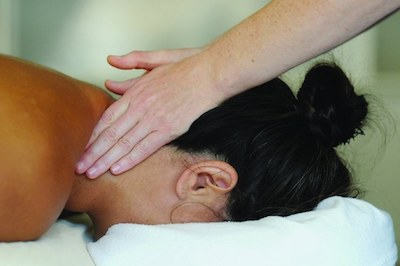by Christobal Mozingo Goodwin, MSN, RN. Board Certified Holistic Nurse
This article will introduce you to Haptic Healing – bodywork techniques that are based on healing touch that release the body’s natural ability to repair itself and stave off disease. Haptic Healing is defined as bringing about beneficial health responses and alleviating discomfort utilizing the sense of touch and proprioception. Intentional touch, acupressure methods, and various massage styles: these are all forms of Haptic Healing techniques to elicit therapeutic responses in the body.
“Haptic Healing” may sound like some new trendy jargon for 21st century healthcare, but the idea of using touch as part of healing is as old as humanity. The concept of using purposeful touch as medicine is so simple that it is often overlooked and undervalued. Unfortunately, there is not mandatory training for most health professionals that include this important aspect of the human dimension and wellness. Many of the current approaches to providing healthcare have forgotten or minimized the potential power of healing touch techniques.
Truth is we are born to touch. We are wired for touch. A square inch of our skin has over 1000 nerves that can send signals which can nurture our physical, mental, emotional, social, intellectual, and spiritual well-being. Unmyelinated nerve fibers, called C tactile fibers or “CT fibers”, are widely distributed throughout our skin. These CT fibers respond to the various Haptic Healing modalities and have been shown to generate a bio-chemical cascade within our bodies.
Haptic techniques stimulate a hypothalamic neurohormone called oxytocin, also known as the “love hormone”. This hormone is secreted by the brain in part due to sensory stimulation and is linked to increased levels of social interaction, well-being, and stress resiliency. Research indicates oxytocin is released in response to low intensity stimulation of the CT fibers in our skin by light touch, massage, and tactile pressures.
Our ancestors recognized the power of touch and how it influences factors related to good mental and physical health. Modern research in cognitive neuroscience and neuroplasticity (confirmed by more than 100 peer-reviewed published studies thus far) document the phenomenal benefits of Haptic Healing over a surprisingly wide range of human ailments including PTSD, pain, wound healing, depression, asthma, auto-immune diseases, cancer, and a host of other health issues.
Engaging in Haptic Healing techniques can increase oxytocin levels resulting in stronger interpersonal social connections, decreased pain sensations, reduced stress reactions, and an increased sense of serenity. As a bodywork practitioner, it is important to recognize that our touch and the Haptic Healing methods we utilize, are built upon a rich historical legacy of therapeutic success and have a solid scientific foundation on which to continue to expand our practice of the healing arts.
References:
Löken, L. S., Wessberg, J., McGlone, F., & Olausson, H. (2009). Coding of pleasant touch by unmyelinated afferents in humans. Nature neuroscience, 12(5), 547-548.
Mason, C., & Mason, E. (2009). Haptic medicine. In Strategy for the Future of Health (pp. 368-385). IOS Press.
Christobal Mozingo Goodwin is a Board Certified Holistic Nurse and Certified Diabetes Educator. He is a Master-prepared Registered Nurse with over 30 years of combined healthcare, wellness, and workplace safety experience. Originally from the Midwest, Chris worked as a travel nurse and spent several years in Arizona before settling in Oregon. Chris can speak Spanish and likes to practice his language skills when opportunities present themselves. He currently works as a Care Manager with Kaiser Permanente and he teaches Anatomy and Physiology for OSM. His areas of holistic healthcare interests include therapeutic bodywork, chakra spiritual healing, and Reiki energy practice.





